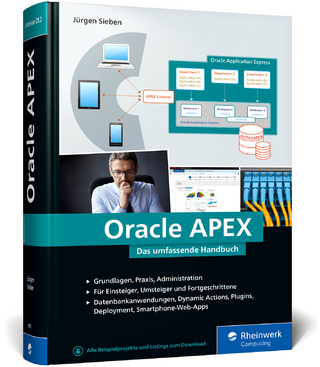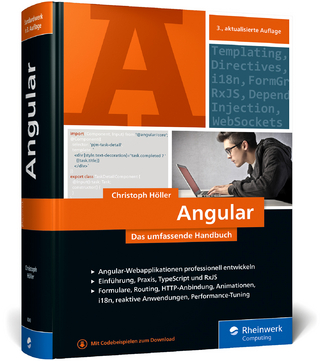
Professional Android Wearables
John Wiley & Sons Inc (Verlag)
978-1-118-98685-1 (ISBN)
- Titel ist leider vergriffen;
keine Neuauflage - Artikel merken
The fast and easy way to get up and running on Android wearables Written by an expert author team with years of hands-on experience in designing and building wearables, Professional Android Wearables covers how to use the Android Wear platform and other techniques to build real-world apps for a variety of wearables including smartbands, smartwatches, and smart glasses. In no time, you'll grasp how wearables can connect us to the Internet in more pervasive ways than with PCs, tablets, or mobile devices; how to build code using Google's Wear SDK for Android-enabled hardware devices; how Android Wear and other Android development techniques are capable of building several presented example projects; and much more. Wearables are the next generation of smart mobile devices, it's no wonder you will want to master Android Wear SDK to build smart wearable apps for a multitude of form factors and applications.
* Shows you how to navigate Android Wear SDK * Clearly explains how to use the Android Wear platform to build real-world apps * The companion website includes source code for all of the projects described in the book If you're an experienced Android developer looking to master Android Wear SDK to build wearable apps, you've come to the right place.
David Cuartielles Ruiz is cofounder of the Arduino platform and creator of the Prototyping Laboratory at Malmo University in Sweden, where he also teaches. He has written libraries that enable Arduino to communicate with Android phones over Bluetooth. Andreas Goransson has been researching and developing wearable projects for over 5 years. His work has included research on connecting to and controlling full-body haptic and audio-augmented suits from Android phones.
INTRODUCTION xix PART I: CONCEPTS CHAPTER 1: INTRODUCTION TO ANDROID WEARABLES 3 The Wearable Revolution 3 Dismantling the Computer: The Cyborg Dream 4 Software Everywhere 5 Fashion is More than Ski Jackets 6 Fitness 6 Time 7 Glasses 8 Summary 9 Recommended Reading 10 CHAPTER 2: THE INTERNET OF THINGS 11 How Wearables Relate to IoT 11 The Promise of Connectivity 12 Cisco s Vision 13 Big Data 13 Connected Devices in the Home 14 Connected Devices on the Go 15 Wireless Sensor Networks 16 A Scenario of Use of WSN 16 Bluetooth Versus ZigBee 17 Smart Cities 17 Summary 18 Recommended Reading 18 CHAPTER 3: PLATFORMS AND TECHNOLOGY 19 Android Wear 19 Installing the Wear SDK 20 Working with the Android Wear Emulator 20 Working with a Real Wear ]Enabled Device 22 Kick ]starting Your Wear Development 24 Distributing Wear Apps on Google Play 25 Summary 26 PART II: BASIC BUILDING BLOCKS CHAPTER 4: NOTIFICATIONS ON SMALL SCREENS 29 About Notifications 29 Pre ]Wear Notification API 30 Wear Notifications 30 Building Notifications 32 The Simple Notification 33 Adding a Large Icon 34 Big Text Notification 35 Big Picture Notification 36 Updating a Notification 38 Adding Pages to Your Notifications 38 Adding Actions to Your Notifications 39 Adding a Standard Action 39 Adding Multiple Actions 41 Adding Wear ]Only Actions 41 Adding an Action without the Extra Page 42 Extra Options 43 Hiding the Application Icon 43 Moving the Notification 44 Setting the Scroll to the Bottom 44 Removing a Notification 45 Stacking Notifications 45 Summary 48 Recommended Reading 48 CHAPTER 5: DEVELOPING WEAR APPS 49 The Wear SDK 49 Design Considerations 49 Wearable UI Library 50 Creating the Wear Project 51 Editing the Gradle Files 55 Loading Layouts 56 Using WatchViewStub 56 Using InsetActivity 58 Building the User Interface 61 Adding Text to Your User Interface 61 CardFrame 61 CardScrollView 62 CardFragment 63 Displaying Images 66 Loading a Static Image 67 Adding a Progress Update 68 Handling Lists in Wear 69 Using WearableListView 69 The 2D Picker 72 Providing Positive Feedback 74 Starting the Success Feedback 75 Starting the Open ]on ]Phone Animation 76 Starting the Failure Feedback 76 Summary 77 Recommended Reading 77 CHAPTER 6: VOICE INPUT 79 Talking to Your Wrist 79 Types of Voice Interaction 80 Using System ]Provided Voice Commands 82 Just Launch an App 84 Hack an Existing Intent to Launch Your App 85 Launch Your App with Voice the Right Way 85 The Wear APIs 85 Data API 86 Message API 86 Node API 86 Answering to Notifications: Capturing Your Voice into an App 86 Creating a Simple App Sending a Notification 87 Creating Your Empty Project 87 Modifying the Gradle File 90 Modifying the App s Layout 91 Adding the Right Callback Function 93 Getting Your App to Receive a Voice Command 95 Revising the Callback Function 95 Adding a Broadcast Receiver 97 Modifying the App s Layout to Include a Text Field 98 Adding the New Class to the Manifest File 99 Adding the Reply String to the Strings File 100 How It Works 100 Showing the Answer on the App s Screen 101 Summary 103 Recommended Reading 104 CHAPTER 7: PUSHING DATA 105 Checking the Example 106 Phone s MyActivityPhone.java 107 Phone s AndroidManifest.xml 111 Wearable s MyActivityWear.java 112 Wearable s AndroidManifest.xml 114 Wearable s Listener 115 Making Your Google API Client from Scratch 116 Start with a Clean Project 117 The Phone s MyActivityPhone.java 117 The Phone s AndroidManifest.xml 119 The Phone s DataLayerListenerService 120 MyActivityWear.java 121 Wear s Android Manifest File 124 The Listener on the Wearable s Side 124 The Final Result 125 Summary 126 Recommended Reading 126 CHAPTER 8: LOCATION-BASED SERVICES ON ANDROID WEAR 127 Changing How Location Works 127 Accessing the Current Location 128 Enabling GPS support 128 Using the New APIs 128 Determining GPS Availability 131 Requesting the Last Known Location 131 Requesting Location Updates 132 Being Picky About Location Updates 134 Showing Your Street Address 135 Testing Geocoder Availability 135 Getting the Current Address for a Location 135 Summary 137 Recommended Reading 137 PART III: PROJECTS CHAPTER 9: ANDROID WEAR AS ACTIVITY TRACKER 141 What Are Activity Trackers? 141 Wear as an Activity Tracker 142 Step Detector 142 Step Counter 143 Building the WalkKeeper App 143 Calculating Calories 143 Creating the Project 145 Selecting Gender 145 Selecting Weight 150 Selecting Height 152 The WalkKeeper Activity 154 Building the User Interface 154 Connecting the User Interface 155 Getting the Stored Settings 157 Reading the Sensor Data 158 Calculating and Updating the User Interface 160 Keeping the Activity Open 162 Improvements 165 Summary 165 CHAPTER 10: SMARTWATCH AS INPUT 167 Android Wear as a Game Controller 167 A Note on Sensors 168 Detecting Gestures 169 Building the Dice Game 169 Creating the Project 169 Designing a User Interface 169 Android Wear GUI 170 Mobile GUI 171 Accessing Sensors 173 Generating the Die Value 175 Connecting to Mobile 176 The Mobile Connection 176 The Wear Connection 178 Keeping the Screen On 182 The Dice Game 182 Improvements 182 Summary 183 Recommended Reading 183 CHAPTER 11: BUILD YOUR OWN GLASS 185 Augmented Reality and Virtual Reality 186 Augmented Reality 186 Google Glass 187 Virtual Reality 188 VR on a Phone 189 Building Your Own Glasses 190 Lenses 190 The Simplest Box Possible 191 The Simplest App 193 The cardboard.jar Library 193 Looking at the Code 194 The Glasses MyActivityPhone.java 194 The Glasses AndroidManifest.xml 196 A Couple More Classes 197 Getting Your Cardboard to Talk to Your Smartwatch 200 Start from the Previous Project 200 The Phone s MyActivityPhone.java 200 The Phone s AndroidManifest.xml 202 The Phone s DataLayerListenerService 203 MyActivityWear.java 204 The Wear Android Manifest File 207 The Final Result 207 Summary 207 INDEX 209
| Erscheint lt. Verlag | 3.4.2015 |
|---|---|
| Verlagsort | New York |
| Sprache | englisch |
| Maße | 187 x 238 mm |
| Gewicht | 414 g |
| Themenwelt | Mathematik / Informatik ► Informatik ► Programmiersprachen / -werkzeuge |
| Informatik ► Software Entwicklung ► Mobile- / App-Entwicklung | |
| Informatik ► Weitere Themen ► Smartphones / Tablets | |
| ISBN-10 | 1-118-98685-7 / 1118986857 |
| ISBN-13 | 978-1-118-98685-1 / 9781118986851 |
| Zustand | Neuware |
| Haben Sie eine Frage zum Produkt? |
aus dem Bereich


